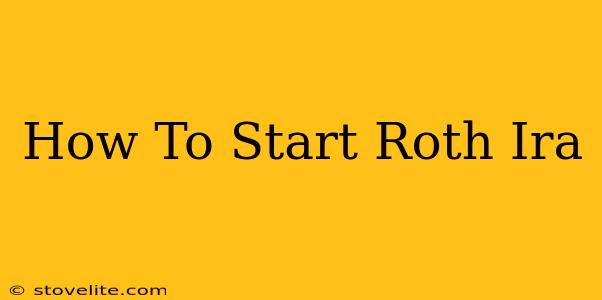Opening a Roth IRA is a smart move for securing your financial future. But with so many options and details, knowing where to begin can feel overwhelming. This comprehensive guide breaks down the process step-by-step, making it easy to understand and implement.
Understanding the Roth IRA
Before diving into the how-to, let's quickly review the what. A Roth IRA is a retirement savings account where your contributions are made after taxes, meaning you pay taxes now but withdrawals in retirement are tax-free. This contrasts with a traditional IRA, where contributions are tax-deductible now but withdrawals are taxed in retirement.
Key Advantages of a Roth IRA:
- Tax-free withdrawals in retirement: Enjoy your retirement savings without the tax burden.
- Tax-free growth: Your investments grow tax-deferred, compounding your returns.
- Flexibility: You can withdraw contributions (but not earnings) at any time without penalty.
Who should consider a Roth IRA?
A Roth IRA is generally a good choice for:
- Younger investors: Those with a longer time horizon benefit most from tax-free growth.
- Individuals expecting a higher tax bracket in retirement: Paying taxes now at a lower rate is advantageous.
- Anyone wanting flexibility with their retirement savings.
Step-by-Step Guide: Opening Your Roth IRA
Now, let's get to the practical steps of opening your Roth IRA.
1. Choose a Custodian
This is where you'll hold your Roth IRA investments. Popular options include:
- Brokerage firms: These offer a wide range of investment choices, research tools, and educational resources. Examples include Fidelity, Schwab, and Vanguard.
- Banks: Some banks offer IRA accounts, often with simpler interfaces but potentially fewer investment options.
- Robo-advisors: These automated platforms manage your investments based on your risk tolerance and goals.
2. Determine Your Contribution Limit
For 2024, the maximum contribution limit is $7,000. If you're age 50 or older, you can contribute an additional $1,000. Keep in mind that these limits can change yearly, so always check the IRS website for the most up-to-date information.
3. Choose Your Investments
Once you've chosen a custodian, you'll need to decide how to invest your money. Options include:
- Stocks: Offer higher growth potential but also carry higher risk.
- Bonds: Generally less risky than stocks but offer lower returns.
- Mutual funds: Diversified portfolios of stocks and/or bonds.
- ETFs (Exchange-Traded Funds): Similar to mutual funds but trade like stocks.
4. Fund Your Account
After selecting your investments, you'll need to fund your Roth IRA. This can be done through various methods, including electronic transfers, checks, or rollovers from other retirement accounts.
5. Review and Monitor
Regularly review your investment performance and adjust your strategy as needed. Keep track of your contributions and ensure you're on track to meet your retirement goals.
Beyond the Basics: Important Considerations
- Income limits: While there are no income limits for contributing to a Roth IRA, there are income limits for fully contributing. If your income exceeds a certain threshold, your contribution may be limited or you may not be eligible. Check the IRS website for the most current income limits.
- Spousal IRA: If you're married, you and your spouse can each open a Roth IRA.
- Tax implications: Understand the tax implications of contributions and withdrawals. Consult a financial advisor if needed.
Starting a Roth IRA is a significant step towards a secure financial future. By following these steps and doing your research, you can confidently begin saving for your retirement. Remember to consult with a financial professional for personalized advice tailored to your specific circumstances.

